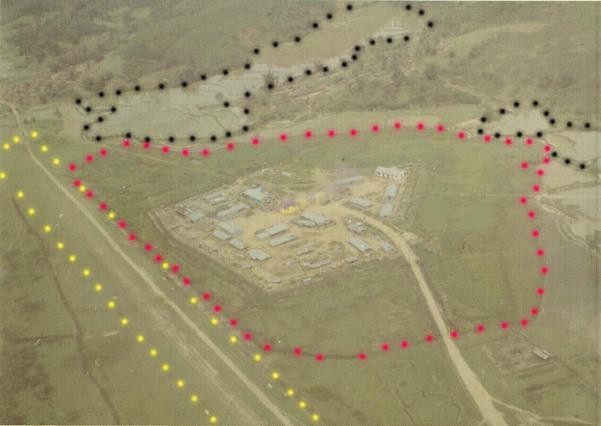Area Adjacent to Gia Vuc Camp
Information about the area surrounding A-103
A-103 Adjacent Area

The areas outlined in black point out some of the rice paddies in the area. I will have more about rice paddies on another page.
The area bounded by yellow was our airstrip -- a 3600' long grass runway. This served as our main supply facility. All of our supplies
were flown in -- mainly by C-123s and CV-2s. C-130s would come in from time to time. 80% of the time the planes would land and we would go
down to the strip and unload the cargo. If time was a factor or if the air crew was worried about ground fire, the aircrew would 'ground lex'
the supplies. Another method used to deliver supplies was 'low lexing'. [See below for details on ground lexing and low lexing]
The area marked in red was an uncharted mine field left over from the French days. On one occasion a C-123 careened off the runway and plowed
right through the mine field. It never detonated a mine. Later, Sgt. Dailey from Dubois, PA -- our Demo guy -- was told by HQ message
to go out and 'clear' the 20-year-old, uncharted mine field. We all laughed at that... but laughed even harder at Dailey's response to HQ:
"If you want the f***ing mine field cleared, YOU come out and do it!"
What was HQS going to do in response to his answer... put him in the Army and send him to Viet Nam?!?
'Ground lexing'
The plane would land and taxi to the unloading area. While the plane taxied, the Crew Chief would release all cargo straps holding the pallets in place. At the unloading area the pilot would turn the plane around and get ready for takeoff. Once ready to leave the pilot would apply the brakes while revving up the engines.Releasing the brakes suddenly would cause the plane lunge forward -- to actually run right out from underneath the cargo! (You know, similar to the magician's old tablecloth and dishes trick!) This procedure was called 'ground [lexing]'.
